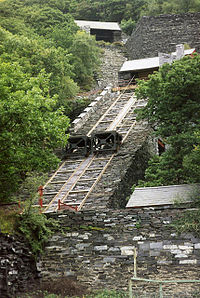Inclined plane railroad

An inclined plane railway is like a big slide that helps with moving things up or down a large hill. Imagine playing with your toy cars on a slide on a playground. If you put one end of the slide on a hill, you could easily slide your toy cars up and down without having to carry them up or down the hill, right? That's exactly what an inclined plane railway does but on a much larger scale!
Instead of toy cars, they use real trains or carts that carry heavy things like coal or iron. The inclined plane railway consists of two tracks, one on a hill or incline and the other parallel to the ground. The hill track is longer and rises gradually, and the ground track is shorter, and it flattens off eventually.
When a train carrying heavy things goes up the hill track, it moves slower than it would on the flat track because it has to work against gravity. But the longer path on the hill track helps to reduce the steepness of the hill, making it easier for the train to climb. Once it reaches the top, the train moves onto the flat track to continue its journey.
This method saves energy because the train doesn't have to pull or push its weights up the steep slope; instead, gravity takes over and pulls down the winds on the upgrade. An inclined plane railway can save a lot of time and effort compared to climbing steep hills by foot or using animals to haul goods, which was common centuries ago.
Overall, an inclined plane railway makes it easier and faster to move heavy things up or down steep hills, getting things where they need to go without using as much energy or taking as much time as traditional methods.
Instead of toy cars, they use real trains or carts that carry heavy things like coal or iron. The inclined plane railway consists of two tracks, one on a hill or incline and the other parallel to the ground. The hill track is longer and rises gradually, and the ground track is shorter, and it flattens off eventually.
When a train carrying heavy things goes up the hill track, it moves slower than it would on the flat track because it has to work against gravity. But the longer path on the hill track helps to reduce the steepness of the hill, making it easier for the train to climb. Once it reaches the top, the train moves onto the flat track to continue its journey.
This method saves energy because the train doesn't have to pull or push its weights up the steep slope; instead, gravity takes over and pulls down the winds on the upgrade. An inclined plane railway can save a lot of time and effort compared to climbing steep hills by foot or using animals to haul goods, which was common centuries ago.
Overall, an inclined plane railway makes it easier and faster to move heavy things up or down steep hills, getting things where they need to go without using as much energy or taking as much time as traditional methods.
Related topics others have asked about:
